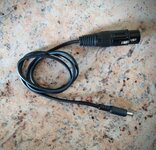Grin Satiator definitely looks promising, if I ever look for a spare charger, I will seriously consider it. It appears to capable to handle just about any charging duties, not just ebikes batteries.
I looked into DIY kits briefly. It sounded like a logical solution and I like tinkering. However, after reading some experiences and people advising against them, I decided to get a properly designed and built ebike from ground up, which is why I'm here. You just can't hide all the wires and electronics inside an existing frame unless it's built for it. Just too much risk and hassle in the long run.
Well... really its just one more set of mechanical skills. Its intimidating until you gain some experience and then its second-nature-simple. There's a standard of care and attention to detail that has to be paid, but you'd better be careful adjusting your bicycle's brakes too, or properly inflating the tires, and most folks have no issue with that ... once they learn the ropes.
Make no mistake I see - daily - DIY abominations put together by people who shouldn't be allowed to cut up a chicken patty at the dinner table without supervision. Some people are better served just writing a check and doing whatever else it is they are good at.
More on-topic to this thread, the Grin Satiator is, internally, pretty much the same thing as an LED power supply with a user interface screen grafted onto it. You can gain the same benefits of that variable current, variable voltage, weather-resistant, fanless long-life device whose MTBF is measured in the hundreds of thousands of hours - without spending the $300. I have a Satiator, but I also have two charging locations (home and work garages) plus on some of my bikes I have mounted the charger to the bike, which is do-able thanks to it being IP65-rated. A Satiator for each one of those applications would be a fortune.
Instead, buy the widely available core power unit, crimp on a plugin input cable (they work on EU power levels automatically; just pick your preferred grounded plug. An electric drill replacement cord from the hardware store works great). Add a watt meter to the output, inline and then your plug to your battery (do what Grin does and do a generic output that plugs to an adapter specific to an individual battery). The pots on the unit itself dial voltage and current. The unit supports CC and will automatically shift to CV as it approaches the dialed voltage target (thats the 'smart' charging people see where the charger tails off current slowly until it stops at the target voltage).
Unfortunately the Satiator or a DIY clone will not help people with a proprietary system like the OP has. You are stuck with what they give you at the price they decide to sell it at, from the sources that have stock.











